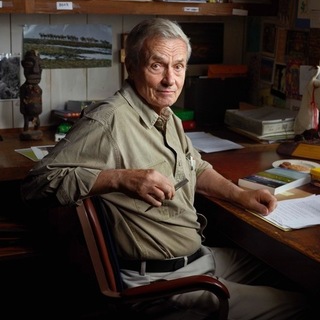George B Schaller
Researcher & Naturalist
George B Schaller - eminent field biologist
George B Schaller (born May 26, 1933) Researcher | Author | Field Biologist
George Beals Schaller (born 1933) is a German-born American mammalogist, biologist, conservationist and author. Schaller is recognized by many as the world's preeminent field biologist (and one of the founding fathers of wildlife conservation), studying wildlife throughout Africa, Asia and South America.
Spending most of his time in the field in Asia, Africa, and South America, he has led seminal studies on, and helped protect, some of the planet’s most endangered and iconic animals ranging from the mountain gorilla in present Democratic Republic of the Congo, snow leopards in Mongolia, jaguars in Brazil, giant pandas in China, tigers in India, lions in Tanzania, wild sheep and goats of the Himalaya. These animals have been the basis for his scientific and popular writings, including 16 books, among them The Year of the Gorilla, The Serengeti Lion, The Last Panda, and Tibet’s Hidden Wilderness.
Over the years, he has accrued a variety of international wildlife conservation awards, including the Tyler Prize for Environmental Achievement, Japan’s International Cosmos Prize, the China Environmental Prize, the Lifetime Achievement Award from the National Geographic Society’s Adventure magazine and the North American Nature Photography Association and the Indianapolis Animal Conservation Prize.
Courtesey panthera.org
Schaller received his Bachelor of Science degree from the University of Alaska in 1955, and went on to the University of Wisconsin–Madison to obtain his PhD in 1962.
In 1959, when Schaller was only 26, he traveled to Central Africa to study and live with the mountain gorillas (Gorilla beringei beringei) of the Virunga Volcanoes. Little was known about the life of gorillas in the wild until the publication of The Mountain Gorilla: Ecology and Behavior in 1963, that first conveyed to the general public just how profoundly intelligent and gentle gorillas really are, contrary to then-common beliefs. Schaller also, in 1964, recounted this epic two-year study in The Year of the Gorilla, which also provides a broader historical perspective on the efforts to save one of humankind's nearest relatives from the brink of extinction.
The American zoologist Dian Fossey, with assistance from the National Geographic society and Louis Leakey, followed Schaller's ground-breaking field research on mountain gorillas in the Virungas. Schaller and Fossey were instrumental in dispelling the public perception of gorillas as brutes, by demonstrably establishing the deep compassion and social intelligence evident among gorillas, and how very closely their behavior parallels that of humans.
In 1966, Schaller and his wife traveled to Tanzania to live in the Serengeti, and Schaller conducted one of the first studies of social behavior and movement of Africa's big cats.
In his 1972 work The Tree Where Man Was Born, author Peter Matthiessen described Schaller as "single-minded, not easy to know". Matthiessen went on to say Schaller was "a stern pragmatist" who "takes a hard-eyed look at almost everything", "lean and intent", and in 1978's The Snow Leopard Matthiessen wrote that by that time, some considered Schaller the world's finest field biologist.
In the fall of 1973, Schaller went to the remote Himalayan region, 250 miles (400 km) inside Dolpo, an area of Nepal occupied by people of the Tibetan culture and ethnicity. Schaller was there to study the Himalayan Bharal, (blue sheep), and possibly glimpse the elusive snow leopard, an animal rarely spotted in the wild. Schaller is one of only two Westerners known to have seen a snow leopard in Nepal between 1950 and 1978. Accompanying him on the trip was Matthiessen, and as a result of the trip, Matthiessen wrote The Snow Leopard, (1978) detailing the accounts of their travels and research, which won two U.S. National Book Awards. Schaller is referred to throughout the book as "GS".
In the late 1970s, Schaller spent time in Brazil studying the jaguar, capybara, "alligator"(caiman), and other animals of the region.
In 1988, Schaller and his wife traveled to China's Chang Tang (Qian Tang) region to study the giant panda, and became the first westerners permitted to enter the remote region. Schaller sought to refute the notion that the panda population was declining due to natural bamboo die-offs. Instead, Schaller found the panda's popularity was leading to its frequent capture, and was the biggest threat to the population. Schaller also found evidence that pandas were originally carnivores, but underwent an evolutionary change to accommodate a diet of bamboo, which is difficult to digest, reducing competition with other animals for food. Since Schaller's research, the panda population has increased in the wild by 45 percent. During his time in China, Schaller would hand out cards to wildlife hunters that read: "All beings tremble at punishment, to all, life is dear. Comparing others to oneself, one should neither kill nor cause to kill." Schaller has spent more time in China than he has spent at his home in Connecticut.
In 1994, Schaller and Dr. Alan Rabinowitz were the first scientists to uncover the rare saola, a forest-dwelling bovine in Laos. Later that year, Schaller rediscovered the Vietnamese warty pig, once thought extinct. In 1996, he located a herd of Tibetan red deer, also thought extinct.
In 2003, Schaller returned to Chang Tang, and found the wildlife in the area had rebounded since his first trip to the region. Most significantly, the wild yak population, which was estimated at only 13 individuals, had grown to over 187. "The Tibet Forestry Department has obviously made a dedicated and successful effort in protecting the wildlife." Schaller wrote in a letter to the World Wildlife Fund's Dawa Cering. While in Tibet, Schaller worked on researching the rare Tibetan antelope, or chiru, whose population declined due to trophy hunting for their exotic wool. Working with Tibetan authorities, and the Liz Claiborne and Art Ortenberg Foundation, Schaller helped protect the breeding and calving grounds of the chiru in the Kunlun mountains of Xinjiang Province.
In 2007, Schaller worked with Pakistan, Afghanistan, Tajikistan, and China to develop a new "Peace Park", that would protect 20,000 miles (32,000 km) of habitat for the largest wild sheep species, the Marco Polo sheep. In danger due to their impressive spiral horns, which can measure up to 6 feet (1.8 m) in length, the sheep is sought out as a trophy by international hunters. Schaller's research in the Pamir Mountains will play an important role in the park's creation.
Schaller's work in conservation has resulted in the protection of large stretches of area in the Amazon, Brazil, the Hindu Kush in Pakistan, and forests in Southeast Asia. Due in part to Schaller's work, over 20 parks or preserves worldwide have been established, including Alaska's Arctic National Wildlife Refuge (ANWR), the Shey-Phoksundo National Park in Nepal, and the Changtang Nature Reserve, one of the world's most significant wildlife refuges. At over 200,000 miles (320,000 km), the Chang Tang Nature Reserve is triple the size of America's largest wildlife refuge, and was called "One of the most ambitious attempts to arrest the shrinkage of natural ecosystems," by The New York Times.
Courtesey Wikipedia.org
Go back to: Researchers & species experts
PUBLICATIONS
Schaller has written more than fifteen books on African and Asian mammals, including Serengeti Lion: A Study of Predator–Prey Relations, The Last Panda, and Tibet's Hidden Wilderness,Tibet the Wild, based on his own studies, and supported by long-term observations of species in their natural habitats. Schaller has also written hundreds of magazine articles, and dozens of books and scientific articles about tigers, jaguars, cheetahs and leopards, as well as wild sheep and goats, rhinoceroses, and flamingos. Over more than five decades, Schaller's field research has helped shape wildlife protection efforts around the world.
Schaller, George B. (1963). The Mountain Gorilla – Ecology and Behavior. University of Chicago Press. p. 431 pages. ASIN B0000CLSDI.
Schaller, George B. (1964). The Year of the Gorilla. Chicago: University of Chicago Press. p. 304 pages. ISBN 0-226-73648-2. Schaller, George B. (1967). The Deer and the Tiger. Chicago: University of Chicago Press. p. 370 pages. Schaller, George B.; Selsam, Millicent E. (1969). The Tiger: Its Life in the Wild. New York: Harper & Row. Schaller, George B. (1972). Serengeti: A Kingdom of Predators. New York: Alfred A. Knopf. ISBN 0-394-47242-X. Schaller, George B. (1972). Mountain Monarchs: Wild Sheep and Goats of the Himalaya. Chicago: University of Chicago Press. p. 472 pages. ISBN 0-226-73641-5. Schaller, George B. (1972). The Serengeti Lion: A Study of Predator-Prey Relations. Chicago: University of Chicago Press. p. 494 pages. ISBN 0-226-73640-7. Schaller, George B. (1973). Golden Shadows, Flying Hooves. New York: Alfred A. Knopf. p. 287 pages. ISBN 0-394-47243-8. Schaller, George B.; Schaller, Kay (1977). Wonders of Lions. New York: Putnam Publishing Group Library. p. 304. ISBN 0-396-07409-X. Schaller, George B. (1980). Stones of Silence: Journeys in the Himalaya. London: Andre Deutsch. p. 292 pages. ISBN 0-233-97215-3. Schaller, George B.; Jinchu, Hu; Wenshi, Pan; Jing, Zhu (1985). The Giant Pandas of Wolong. Chicago: Univ. of Chicago Press. ISBN 0-226-73643-1. Schaller, George B. (1993). The Last Panda. Chicago: University of Chicago Press. p. 312 pages. ISBN 0-226-73628-8. Schaller, George B. (1997). Tibet's Hidden Wilderness: Wildlife and Nomads of the Chang Tang Reserve. New York: Harry N. Abrams. p. 168 pages. ISBN 0-8109-3893-6. Schaller, George B. (1998). Wildlife of the Tibetan Steppe. Chicago: University of Chicago Press. p. 383 pages. ISBN 0-226-73653-9. Schaller, George B.; Vrba, Elisabeth S., eds. (2000). Antelopes, Deer, and Relatives: Fossil Record, Behavioral Ecology, Systematics, and Conservation. New Haven, Conn: Yale University Press. p. 356 pages. ISBN 0-300-08142-1. Schaller, George B. (2007). A Naturalist and Other Beasts: Tales From a Life in the Field. San Francisco, Calif: Sierra Club Books. p. 272 pages. ISBN 1-57805-129-0. Schaller, George B. (2012). Tibet Wild: A Naturalist's Journeys on the Roof of the World. Washington, DC: Island Books. ISBN 1-61091-172-5.Courtesey Wikipedia.org
ARTICLES OF INTEREST
Academy of Achievement: Wonder of the Natural World - George B Schaller (and interview 2017)




